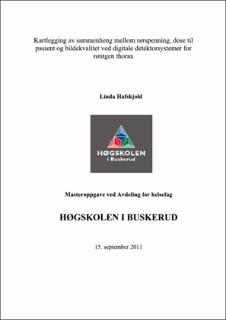| dc.contributor.advisor | Stranden, Erling | |
| dc.contributor.advisor | Seierstad, Therese | |
| dc.contributor.author | Hafskjold, Linda | |
| dc.date.accessioned | 2023-02-08T13:41:15Z | |
| dc.date.available | 2023-02-08T13:41:15Z | |
| dc.date.issued | 2011 | |
| dc.identifier.uri | https://hdl.handle.net/11250/3049363 | |
| dc.description.abstract | Bakgrunn og hensikt: Valg av eksponeringsparameter og oppsett for røntgen thorax, påvirker både dose til pasient og diagnostisk bildekvalitet. Litteratursøk omhandlene digital detektorteknologi og valg av rørspenning, indikerer mulighet for økt bildekvalitet til samme eller redusert dose. Hensikten med prosjektet er å kartlegge sammenhengen mellom rørspenning, dose til pasient og bildekvalitet for utvalgte digitale detektorsystem.
Metoder: Fantomstudie: Doseavsetning i vev ble målt ved hjelp et mobilt ionisasjonskammer i tre ulike målepunkter i et fantom. Dette ble målt med ulike objekttykkelser og for ulike rørspenninger (90-150 kVp ). Bildeopptak med ulike rørspenninger (90-150 kVp) ble utført på et thoraxfantom på to ulike digitale detektorsystem. Bildekvalitet ble vurdert for disse bildeopptakene ved hjelp av CNR (contrast to noise ratio), lavkontrastgjengivelse og spatial oppløsning. En testprotokoll ble utviklet basert på fantomstudiene for et av de digitale detektorsystemene.
Klinisk studie: Røntgen thorax med testprotokoll (110 kVp) og standard protokoll (130 kVp) ble utført på et dedikert, digitalt thorax system. Bildeopptak (frontprojeksjon) av 41 pasienter ble inkludert og avidentifisert. Bildeopptakene fra hver pasient med ulik rørspenning ble visuelt gradert etter gitte bildekriterier av tre radiologer. Dataene ble analysert ved hjelp av statistiske metoder.
Etiske hensyn: Etiske aspekter er vurdert ved de enkelte delstudiene. Pasientstudien er godkjent av Regional Etisk Komite og helseforetakets eget personvern ombud. Pasienter er inkludert i studien ved skriftlig, informert samtykke.
Resultater: Fantomstudie: Det er mindre enn 1 mGy forskjell i gjennomsnittlig dose avsatt i fantomet mellom rørspenningene 125 og 109 kVp ved den tykkeste objektstørrelsen som er målt. Redusert rørspenning gir økt lavkontrastgjengivelse og spatial oppløsning. Pasientstudien viser at radiologer graderer bildeopptak med redusert rørspenning til å ha lik eller bedre bildekvalitet sammenlignet med bildeopptak ved standard rørspenning. Dette er uavhengig av BMI (Body Mass Indeks)
Konklusjon: Fantomstudien bekrefter tidligere studiers funn av at redusert rørstrøm gir økt bildekvalitet ved digitale detektorsystem. Radiologers gradering av bildeopptak med ulik rørspenning indikerer at bildekvalitet er like god eller bedre for bildeopptak med testprotokoll ( 110 kVp) for aktuelt thoraxsystem. Dersom effektiv dose reduseres ved lavere rørspenning, vil dette kunne gi samme bildekvalitet til lavere dosebelastning for pasienten. En evaluering av høy rørspenning som beste alternativ i forhold til ALARA prinsippet bør derfor vurderes. | en_US |
| dc.description.abstract | Background and aim: The choice of exposure parameters and procedure for chest imaging affects both patient dose and diagnostic image quality. A search of the available literature regarding digital detector quality and the choice of tube potential indicates the possibility ofimproving image quality at the same or reduced dose. The aim ofthis study is to survey the correlation between tube potential, patient dose and image quality for a chosen digital image detector system.
Methods and materials: Phantom study: Absorbed dose was measured using a mobile ionisation chamber at three discrete points of an x-ray phantom. Dose was measured at varying object thicknesses and tube potentials (90 -150kVp ). Image acquisition using varying tube potential (90-150 kVp) was performed for two different digital detector systems using a thorax phantom. Image quality for these acquisitions was considered by; CNR ( contrast to noise ratio), low contrast detection and spatial acuity. A test protocol was then developed based upon the observations of the phantom study for the digital imaging detector systems.
Clinical Study: X-ray thorax was performed using a dedicated digital chest imaging system first with the test protocol (1 lOkVp) and thereafter the standard protocol (130kVp). Image acquisition (frontal projection) of 41 patients was obtained and subsequently anonymised. The image acquisition from each patient (with both protocols included) was visually graded by three radiologists using a given set of image criteria. The data was analysed using inferential statistical tests.
Ethical considerations: Ethical consideration was given to each of the study components. The study was approved by the Regional Ethics Committee and the Hospital's own patient protection group. All included subjects have given written, informed consent.
Results: Phantom study: in the thickest objects measured, there was less than lmGy difference in the average dose absorbed in the phantom at tube potentials between 125 and 109 kVp. Reduced tube potential gave increased low contrast detection and spatial acuity. The clinical study suggested that radiologists graded the images produced with lower tube potential, as being of equal or hetter quality than those produced using the standard protocol. This was shown to be independent ofBMI (body- mass index).
Conclusion: The phantom study confirmed the conclusions from earlier studies; lower tube potential results in increased image quality in digital image detector systems. Radiologists' grading of image acquisition at different tube potentials show that image quality using the test protocol (1 l0kVp) was as good or hetter than the standard protocol for the actual digital chest imaging system. If effective dose is reduced at lower tube potential, then image quality can be maintained at a lower dose to the patient. An evaluation of high tube potential as the best alternative in respect to the ALARA ( as low as reasonably achievable) principle, should be considered. | en_US |
| dc.language.iso | nob | en_US |
| dc.publisher | Høgskolen i Buskerud | en_US |
| dc.title | Kartlegging av sammenheng mellom rørspenning, dose til pasient og bildekvalitet ved digitale detektorsystemer for røntgen thorax | en_US |
| dc.type | Master thesis | en_US |
| dc.description.version | publishedVersion | en_US |
| dc.rights.holder | Copyright The Author | en_US |
